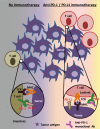Tumor-associated macrophages-additional effectors at anti-PD-1/PD-L1 therapy?
- PMID: 29268470
- PMCID: PMC5720976
- DOI: 10.21037/jtd.2017.10.15
Tumor-associated macrophages-additional effectors at anti-PD-1/PD-L1 therapy?
Conflict of interest statement
Conflicts of Interest: The author has no conflicts of interest to declare.
Figures


Comment on
-
PD-1 expression by tumour-associated macrophages inhibits phagocytosis and tumour immunity.Nature. 2017 May 25;545(7655):495-499. doi: 10.1038/nature22396. Epub 2017 May 17. Nature. 2017. PMID: 28514441 Free PMC article.
References
Publication types
LinkOut - more resources
Full Text Sources
Other Literature Sources
Research Materials
